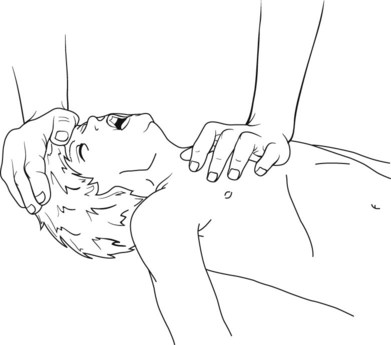Procedures based on BLS for healthcare providers, Dallas, 2010, American Heart Association (AHA). This section may be photocopied and distributed to families. Spanish translation of this handout available at http://evolve.elsevier.com/Wong/clinical. Before beginning CPR, you must evaluate the child to determine if he/she is responsive and breathing. CPR is performed when the child remains unresponsive to voice commands and touch. You can do the work of the heart by doing a chest compression. The heart can be squeezed between the breastbone and the backbone to force blood out of the heart and into the arteries that carry it to the rest of the body. When you remove the pressure, the heart fills with blood so that the next squeeze (compression) will force additional blood out to the body. You can breathe for the child by blowing air into the lungs.§ Between breaths, the chest falls and air flows out of the lungs. • If trauma is suspected, do not move the child’s head or neck. Avoid moving the child unless she is in danger of further injury. If you need to turn the child over, roll the head and torso as a unit, supporting head and neck to prevent movement that could cause further injury. • Try to wake the child. Tap the child, say her name loudly, clap your hands, or shake shoulders gently to look for a response or movement. • If the child is still unresponsive, begin CPR at once by performing 30 chest compressions (do not check for a pulse). • Open the airway and administer two breaths (see “Airway,” later). • If there is someone else with you, have him or her call the emergency telephone number (911) for help and obtain an automated external defibrillator (AED). If you are alone, do not stop to call, but begin CPR immediately. Do CPR for 2 minutes (30 compressions and 2 breaths each cycle), then call the emergency number as quickly as possible. • After you have established that the child is unresponsive and not breathing, administer 30 chest compressions. • Locate the correct (Figure 1) position for chest compressions. Use one hand to maintain the child’s head position. Place the heel of the other hand in the center of the child’s chest (breastbone) at an imaginary line drawn between the nipples. Avoid compressing the child’s lower chest where the ribs meet the breastbone. Feel the notch: you must avoid pressing at this spot. The fingers of the hand on the chest should be pointing away from you, across the child’s chest.
Wilson & Hockenberry: Wong’s Clinical Manual of Pediatric Nursing, 8th Edition
Patient Teaching Guide
Child Cardiopulmonary Resuscitation for the Layperson*†‡
Equipment
Circulation
![]()
Stay updated, free articles. Join our Telegram channel

Full access? Get Clinical Tree


Wilson & Hockenberry: Wong’s Clinical Manual of Pediatric Nursing, 8th Edition: Patient Teaching Guide

